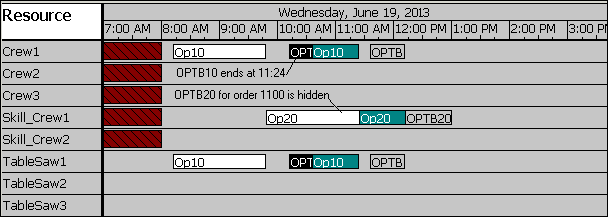Examples: Resource Planning
The two examples below illustrate how the APS planning mode and Infinite APS planning mode plan resources when processing the same 4 jobs.
Input Data
The following input data is used in both examples.
- Resource groups:
- "Crew" (labor): contains 3 resources (Crew1, Crew2, and Crew3).
- "Skill_Crew" (labor): contains 2 resources (Skill_Crew1 and Skill_Crew2).
- "TableSaws" (machine): contains 3 resources (TableSaw1, TableSaw2, and TableSaw3).
- Shifts: all labor resources are on-shift from 8:00 a.m. to 4:00 p.m. M-F. All machine resources are not on a shift (that is, they are always available).
- End items: a chair and a table.
- Routing for Chair:
- Op10 (Cut): requires 1 resource from Crew and 1 resource from TableSaws. Run duration is 0.1 hours per piece.
- Op20 (Assemble): requires 1 resource from Skill_Crew. Run duration is 0.2 hours per piece.
Note: Both the chair and the table require the same purchased components, but purchased components won't be a constraining factor in this illustration. - Routing for Table:
- OPTB10 (Cut): requires 1 resource from Crew and 1 resource from TableSaws. Run duration is 0.3 hours per piece.
- OPTB20 (Assemble): requires 1 resource from Skill_Crew. Run duration is 0.4 hours per piece.
APS Example
Assume the planning mode is APS. There are currently 4 jobs in the system, each with a single line item. The operations for each order are grouped by the same color/shading for clarity in the example picture.
Orders:
- 1100 (Table): Qty 4, Color=Black
- 1200 (Chair): Qty 16, Color=White
- 1300 (Chair): Qty 8, Color=Green
- 1400 (Table): Qty 2, Color=Gray
All orders are due on 6/19/2002 at 2:00 p.m.
After planning these jobs, you can view how the resources are planned using the Resource Gantt Chart (shown below). Each bar represents an operation.

Because APS mode considers the resources to have finite capacity, the system loads most of the available resources in order to complete the job by the due date.
Infinite APS Example
Now assume the planning mode is Infinite APS and consider the same 4 jobs from the APS example above. The resulting Gantt chart is shown below.

Notice that the Crew1, Skill_Crew1, and TableSaw1 resources are doing the same work that in APS mode was distributed across several resources. Because Infinite APS mode considers the resources to have infinite capacity, only one of each required resource type is loaded.